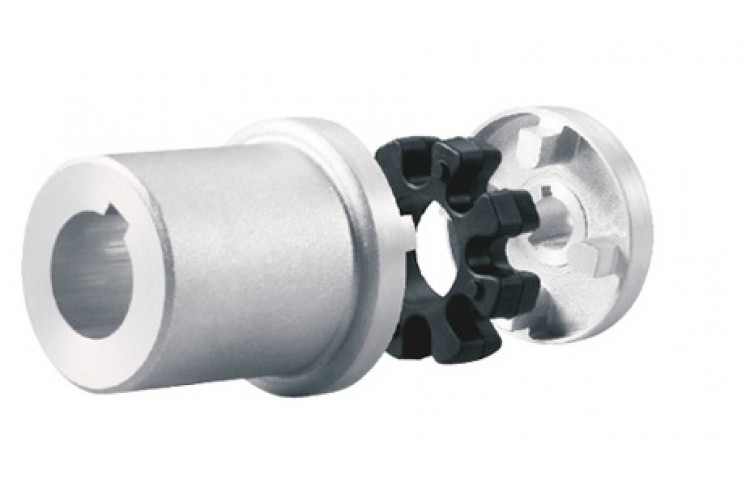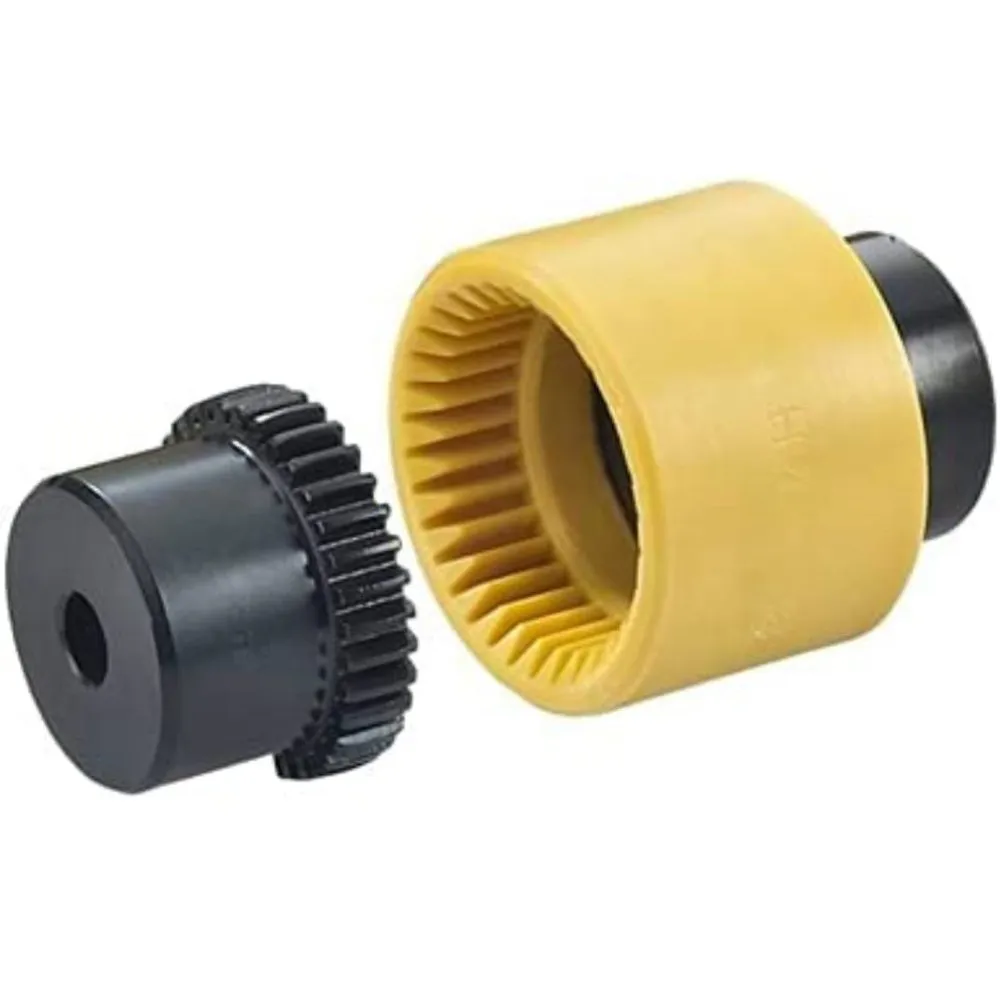Product Description
Flexible Coupling Flange Industrial Shaft Rubber Motor Disc Drive Stainless Steel Couplings Best Transmission Parts High Quality Good Price Flexible Coupling
Application of Flexible Coupling
Flexible couplings are used to transmit torque from 1 shaft to another while allowing for some misalignment between the shafts. This makes them ideal for applications where the shafts are not perfectly aligned, such as when the equipment is installed in a new location or when the equipment is subject to vibration.
Flexible couplings are available in a variety of types, each with its own advantages and disadvantages. Some of the most common types of flexible couplings include:
- Jaw couplings: Jaw couplings are made of 2 or more jaws that are clamped together around the shafts. The jaws allow the shafts to move slightly relative to each other, which helps to compensate for misalignment. Jaw couplings are relatively inexpensive and easy to install.
- Hitchcock couplings: Hitchcock couplings are made of a series of discs that are connected by springs. The discs allow the shafts to move slightly relative to each other, which helps to compensate for misalignment. Hitchcock couplings are more expensive than jaw couplings, but they are also more durable.
- Spider couplings: Spider couplings are made of a series of spiders that are connected by springs. The spiders allow the shafts to move slightly relative to each other, which helps to compensate for misalignment. Spider couplings are more expensive than jaw couplings and Hitchcock couplings, but they are also more durable and can withstand higher torques.
The best type of flexible coupling for a particular application will depend on the specific requirements of that application. Factors to consider include the amount of misalignment that needs to be compensated for, the torque that needs to be transmitted, and the cost.
Here are some of the applications of flexible couplings:
- Machine tools: Flexible couplings are used in machine tools to transmit power from the motor to the machine. This allows the machine to operate even if the motor and machine shafts are not perfectly aligned.
- Conveyors: Flexible couplings are used in conveyors to transmit power from the motor to the conveyor belt. This allows the conveyor to operate even if the motor and conveyor belt shafts are not perfectly aligned.
- Pumps: Flexible couplings are used in pumps to transmit power from the motor to the pump shaft. This allows the pump to operate even if the motor and pump shafts are not perfectly aligned.
- Fans: Flexible couplings are used in fans to transmit power from the motor to the fan shaft. This allows the fan to operate even if the motor and fan shafts are not perfectly aligned.
- Compressors: Flexible couplings are used in compressors to transmit power from the motor to the compressor shaft. This allows the compressor to operate even if the motor and compressor shafts are not perfectly aligned.
Overall, flexible couplings are a versatile and reliable type of coupling that can be used in a wide variety of applications. They offer a number of advantages over other types of couplings, but they also have some disadvantages. The best type of coupling for a particular application will depend on the specific requirements of that application.
/* January 22, 2571 19:08:37 */!function(){function s(e,r){var a,o={};try{e&&e.split(“,”).forEach(function(e,t){e&&(a=e.match(/(.*?):(.*)$/))&&1

Can Drive Couplings Handle Reversing Loads and Shock Loads Effectively?
Yes, drive couplings are designed to handle reversing loads and shock loads effectively in various industrial applications. Their ability to accommodate these dynamic loads makes them suitable for many power transmission scenarios. Here’s how drive couplings handle reversing loads and shock loads:
- Reversing Loads: Drive couplings, especially flexible couplings like elastomeric, grid, and gear couplings, can handle reversing loads without difficulty. These couplings have torsional flexibility, which allows them to compensate for angular misalignments and absorb shocks during load reversals. As the direction of the load changes, the coupling flexes and adjusts accordingly, minimizing stress on the connected equipment. This flexibility also reduces the wear and tear on both the coupling and the connected machinery, leading to improved durability and extended service life.
- Shock Loads: Drive couplings are engineered to handle shock loads efficiently. Shock loads are sudden, high-intensity forces that can occur during equipment start-ups, stops, or unexpected changes in operating conditions. Elastomeric couplings are particularly effective in damping these shock loads due to the flexibility of their elastomeric elements. Grid couplings with a spring-like grid structure and gear couplings with rigid teeth also excel at distributing and absorbing shock loads. Even chain couplings, designed with roller chains, can effectively handle shock loads by absorbing the impact through the rollers and chain links.
When selecting a drive coupling for an application that involves reversing loads or shock loads, it’s essential to consider factors such as the magnitude and frequency of the loads, the operating environment, and the specific coupling’s design capabilities. Manufacturers often provide load capacity charts and guidelines to help users select the appropriate coupling for their requirements.
Proper maintenance and regular inspections are also essential to ensure that the coupling remains in good working condition. Monitoring the coupling’s performance and addressing any signs of wear or damage promptly can prevent unexpected failures and enhance the overall reliability of the power transmission system.

Understanding the Torsional Stiffness and Damping Characteristics of Drive Couplings
Torsional stiffness and damping are essential characteristics of drive couplings that play a significant role in the performance and behavior of mechanical power transmission systems. Let’s explore these two properties:
Torsional Stiffness:
Torsional stiffness refers to the ability of a drive coupling to resist angular deflection or twisting when subjected to a torque load. It is a measure of the coupling’s rigidity and is typically represented by a spring constant. A coupling with high torsional stiffness will exhibit minimal angular deflection when torque is applied, providing a more direct transfer of rotational power. On the other hand, a coupling with lower torsional stiffness allows for some flexibility and misalignment tolerance.
Drive couplings with high torsional stiffness are commonly used in applications where precision and accurate torque transmission are crucial, such as precision machinery and high-speed power transmission systems. Couplings with lower torsional stiffness are employed in situations where flexibility and shock absorption are needed to protect connected components from sudden torque spikes and vibrations.
Torsional Damping:
Torsional damping characterizes the ability of a drive coupling to dissipate energy in the form of heat when subjected to torsional vibrations. Damping reduces the amplitude of vibrations and prevents resonance, which can be detrimental to the coupling and the entire power transmission system.
Drive couplings with adequate torsional damping can absorb and dampen torsional vibrations, preventing excessive wear on the coupling and the connected machinery. The damping capacity of the coupling is determined by its material properties and design. High torsional damping is especially important in applications where the drive system experiences varying torque loads and vibrations, as it helps maintain stability and extends the life of the coupling and other mechanical components.
Both torsional stiffness and damping are critical factors to consider when selecting a drive coupling for a specific application. The appropriate coupling choice will depend on the desired level of rigidity, flexibility, and vibration absorption required for the mechanical power transmission system.

How to Diagnose and Fix Common Problems with Drive Couplings?
Drive couplings, like any mechanical component, can experience issues over time. Diagnosing and fixing these problems promptly is essential to ensure the proper functioning of the power transmission system and prevent further damage. Here’s a step-by-step guide to diagnose and fix common problems with drive couplings:
- Visual Inspection: Start by visually inspecting the drive coupling and surrounding components. Look for signs of wear, cracks, or damage in the coupling’s flexible elements, bolts, and connections.
- Check for Misalignment: Misalignment is a common cause of drive coupling problems. Use alignment tools to check if the shafts connected by the coupling are properly aligned. Misalignment can lead to premature wear and vibration issues.
- Listen for Unusual Noises: Unusual noises like clunking, rattling, or grinding may indicate problems with the drive coupling. Pay attention to any sounds while the vehicle is in motion.
- Inspect for Fluid Leaks: Check for any transmission fluid leaks around the drive coupling area. Fluid leaks can lead to insufficient lubrication and cause further damage.
- Test for Slippage: Slippage can occur if the drive coupling is not securely transmitting power. Perform tests to see if the transmission slips out of gear or has difficulty engaging.
- Monitor Power Loss: If the vehicle experiences power loss or reduced acceleration, it may be due to a faulty drive coupling. Monitor the engine’s performance and power delivery.
- Inspect Bolts and Fasteners: Loose or worn bolts and fasteners can lead to coupling problems. Check and tighten all connections as needed.
- Examine Torsional Flexibility: For flexible drive couplings, assess the torsional flexibility to ensure it can accommodate torque fluctuations and prevent damage from torque spikes.
- Replace Damaged Coupling: If you find any issues with the drive coupling during inspection, replace the damaged coupling with a new one that matches the required specifications.
- Realign Shafts: If misalignment is detected, realign the shafts to the manufacturer’s recommended tolerances. Proper alignment will help prevent future problems.
- Lubricate as Needed: Some drive couplings require periodic lubrication. Ensure that the coupling is adequately lubricated as per the manufacturer’s guidelines.
- Perform Test Runs: After fixing the drive coupling or making adjustments, perform test runs to ensure that the transmission functions smoothly and there are no unusual noises or vibrations.
It’s essential to follow the manufacturer’s guidelines and maintenance schedules for the specific drive coupling used in your vehicle. Regular maintenance and inspections can help identify and address potential problems early, preventing costly repairs and ensuring the longevity of the power transmission system.


editor by CX 2024-03-29
by
Tags:
Leave a Reply